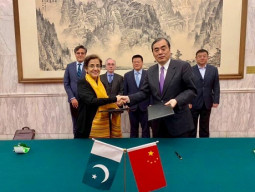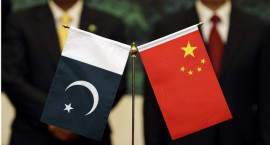
Fifty years ago China was a poor country with little influence in the international sphere. During that time Pakistan forged a special relationship with China, initially centred on diplomatic realm but quickly spreading towards strategic and economic underpinnings. Since becoming independent, both countries have taken different development trajectories. Pakistan has been buffeted by political and economic problems and has failed to grow at anywhere near its potential. On the other hand, China’s rapid economic growth has made it an economic powerhouse that increasingly plays a leading role on the world stage.
The most iconic manifestation of China’s increased economic and political clout is the Belt and Road Initiative (BRI) that aims to link markets in Europe and Asia. The initiative — with its Pakistan-specific arm, the China-Pakistan Economic Corridor (CPEC) — is largely about improving trade and logistics. Lately, however, there has been an indication that the focus of CPEC could shift towards socio-economic outcomes of investment, including via support to the agriculture sector of Pakistan. The agriculture sector has grown at a meagre average rate of 2.4% since 2011-12, according to the Pakistan Economic Survey of 2017-18. This poor performance has been a drag on overall growth of the economy as well on key indicators of rural wellbeing such as levels of malnutrition, education and health.
It is yet unclear what China’s support to Pakistan in the field of agriculture and rural development would entail, as discussions are currently underway to define the scope of work. A significant part of these discussions will likely focus on specific investment opportunities. Pakistan is well endowed in natural resources and could produce a wide range of crops for the Chinese markets. The Chinese stakeholders will, therefore, be looking to link up with medium and large farmers to exploit these opportunities. Chinese investors, however, have superior bargaining power and there is risk that the terms of agreement may be tilted in their favour, especially in agriculture and agro-processing industries where Pakistani enterprises tend to be small with limited financial and administrative skills.
In this situation, the government needs to provide laws, regulation and guidelines to make sure those contracts are fair and equitable. The critical aspects include ensuring that financial and other charges, like for insurance, are in line with international regulations; prices paid for the Pakistani produce are fair and there is no ‘transfer pricing’, that is, taxes, duties and other local provincial and federal levies are fully paid in time; negative environment impacts are mitigated and remedial actions put in place; and alongside payment of fair wages current farmers and tenants are not displaced from their lands and houses. The Chinese investment should not simply be seen as an opportunity to earn quick returns but to cultivate a long-term partnership based on mutual benefits shared across the board. In addition, these conditions, including transfer pricing, are common for transnational investors around the world.
From a policy point of view, there are also important lessons from the Chinese approach towards agricultural and rural development that could be useful for Pakistan. Focus on agricultural growth has been the mainstay of Chinese efforts in stimulating overall growth and raising standards of living. Beginning from 1970s, the country has made a conscious attempt to introduce reforms in the agriculture sector, before moving on to services and manufacturing sector. Improvements in agricultural growth in China have in turn led to a positive impact on reducing poverty and hunger in the country. It has been estimated that the growth in Chinese agriculture contributed to reducing poverty four times compared to other sectors.
According to data from the World Bank, the share of people living below the poverty line of $1.90 decreased impressively from 67% in 1990 to 0.7% in 2015. In Pakistan during the same time poverty also declined, from 59% to 4% albeit at a relatively lower rate than China. There are still 7.7 million extremely poor people in Pakistan living on $1.90 a day. While poverty has come down in Pakistan, hunger numbers present a different story, especially in comparison with the situation in China. According to the Food and Agriculture Organisation (FAO) of the United Nations, from 2000 to 2016, China saw a decrease in the share of population experiencing undernourishment, from 16% to 9%. In Pakistan, during the same time, the percentage of population experiencing hunger has remained more or less the same: coming down from 23% to 21% only.
The question then is: Should Pakistan replicate China’s model? The answer points to three factors: incentivising smallholder production; enhanced access and adoption of agricultural technologies; and strengthened and comprehensive policy. Improved incentives for smallholder farmers proved to be a key catalyst for agricultural growth in China. The country undertook a series of reforms focusing on de-collectivisation of the agriculture system, de-centralisation of rural production, land rights, and pricing policies for agricultural commodities. This is critical for Pakistan given that the vast majority of farmers in the country can be classified as smallholders.
The performance of agriculture in China has been supported by enhanced investments in agricultural research and development (R&D). The expenditures in agricultural R&D have increased over the last four decades leading to innovation and technological development in agriculture. In particular, China invested in the development and adoption of high-yielding seed varieties that gave a boost to food security and agricultural growth.
More importantly, agricultural reforms in China were driven by strong political will and a reliance on evidence-based policy making. The leadership has given due consideration to the policy advice and guidance coming out of research institutions. Secondly, periodic investments in rural infrastructure (including roads, electricity, and telecommunications) contributed to increasing agricultural growth, reducing poverty and raising standards of living.
In essence, the Chinese experience points to the potential that agriculture has in stimulating sustainable development. The agricultural policy-making can draw useful lessons from the Chinese experience to transform the sector, which at present contributes almost 19% to the country’s economy and employs 40% of the total labour force.
Published in The Express Tribune, April 13th, 2019.
Like Opinion & Editorial on Facebook, follow @ETOpEd on Twitter to receive all updates on all our daily pieces.





















































COMMENTS
Comments are moderated and generally will be posted if they are on-topic and not abusive.
For more information, please see our Comments FAQ